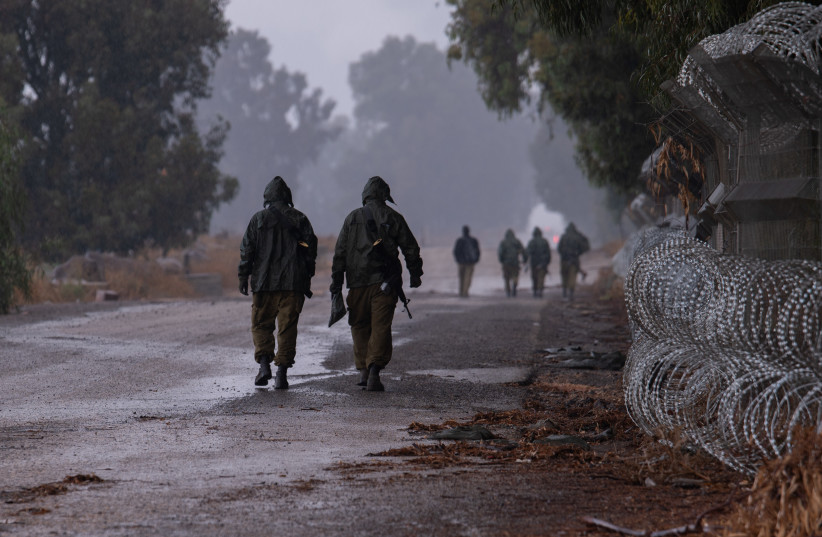Rain fell and soaked soldiers and their equipment over Saturday night, in one of the first major downpours since the war between Israel and Hamas began on October 7.
The conflict is set to continue into the winter amid changing weather conditions. The impact of weather on warfare should not be underestimated just because much of the modern world has isolated itself from harsh conditions.
Historically, weather has turned the tides of decisive battles and the outcomes of whole wars. Storms have destroyed fleets, such as the Spanish Armada in 1588, and cold has crippled infantry, as it did when Napoleon’s forces tried to invade Russia in 1812 and when Hitler tried to invade the Soviet Union in 1941.
As the Levant enters winter, the effects on combatants and civilians will become more pronounced, and military planners and humanitarian organizations will need to prepare to address the associated challenges.
The most immediate weather change will be rain. Rain will create mud and difficult terrain for some vehicles to traverse, slowing down movement. Some vehicles can get stuck, which at the front makes them vulnerable targets, and within friendly territory can delay the delivery of vital supplies.
Some aerial vehicles may be grounded by heavy rain. Flying in the rain will also be a challenge for the modified commercial drones that compose Hamas’s air force. These drones, used for reconnaissance, directing mortar fire, and dropping bombs, will have difficulty flying in heavy rain and could suffer damaged electronics and reduced visibility.

'Mud and rain will put a damper on all combatants'
Cameras and optics – those that remain following the Hamas attacks – may also see reduced visibility during rain.
Infantrymen will have their uniforms and equipment soaked with rain, making their loads all the more heavy. Mud can be as troubling to foot soldiers as to vehicles, weighing down boots and even temporarily stopping them. Lying down in mud, which may be necessary in stakeouts and combat, will be an unpleasant experience without proper gear. If the mud enters weaponry, it may lead to jams and an inability to fire.
Mud and rain will put a damper on all combatants. The winter will also bring the cold, with nights already becoming a bitter ordeal. Morale cannot be discounted as a war resource. While armies may march on their stomachs, they fight with their hearts. Hamas supporters may be under the impression that their suicidal terrorists would be immune to such demoralization, but that someone is willing to die does not mean he is ready to suffer.
Hamas may also suffer flooding in their vast network of subterranean tunnels. Without knowing too much about their systems, heavy rainfall could cause death and render some passages impassable.
If there is enough rain, it could cause flooding above ground as well, threatening civilians in Gaza. If this water is left to stand, waterborne illness could proliferate. Disease has shaped the course of war as much as any storm, and tightly packed soldiers and internally displaced persons are prime vectors for transmission.
Heat and cold each pose their own threats
Unprotected from cold and rain, soldiers and civilians alike are in danger of hypothermia. In the developed world, we often consider the cold to be a minor hindrance, since we have protective clothing and shelter. For those without it, cold weather can easily be a death sentence.
Soldiers can also encounter the opposite problem of overheating, in which they may layer on warm clothing like leggings and thermal shirts, but may be unable to remove them when forced into action. The exertion and the extra layers may lead to heat exhaustion.
In cold periods, soldiers may also find themselves not feeling the need to rehydrate as often, and may only discover their lack of water once they’ve dehydrated during strenuous activity.
During cold nights and hot days, fog may present a problem in the mornings. Fog is a natural smoke screen that can conceal movement not just for soldiers in its midst, but also cameras and aircraft flying above. This reduces the ability of helicopters, warplanes, and drones to provide aerial support to infantry and armor during the already perilous low-visibility dawn hours.
These are just some of the considerations that NGOs helping refugees and IDF officers will need to take into account in the coming days. Experts in different armor, air, naval, and ground warfare technologies and specializations will no doubt be able to identify more challenges.
The writer is an IDF infantry reservist serving in the Gaza periphery towns that have been attacked by Hamas.
